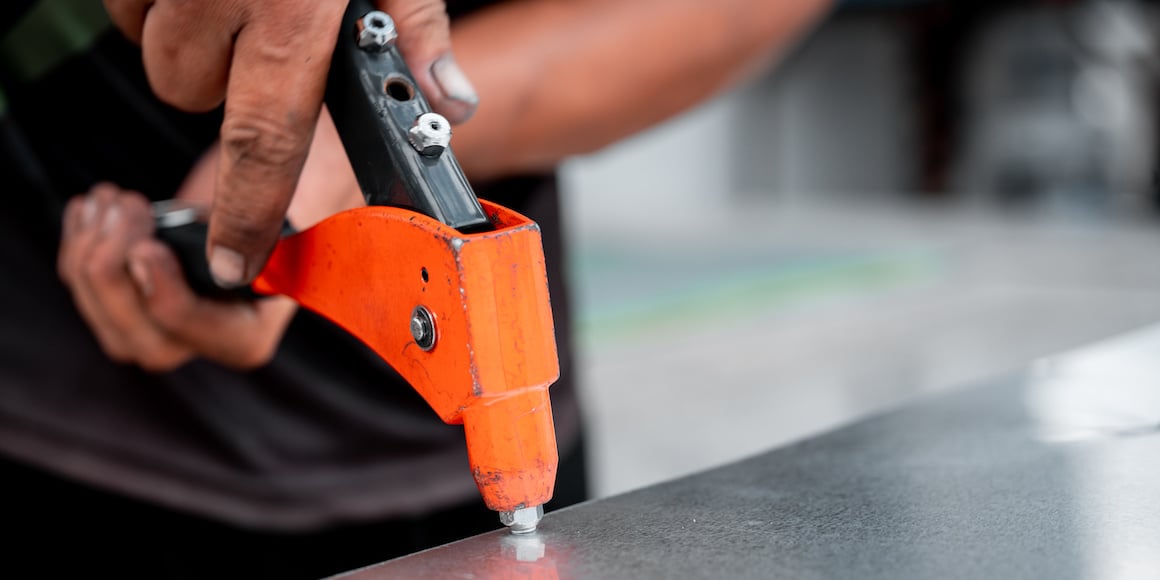
Rivets are always the best type of fastener for the job. Sometimes you want the security of a rivet but may need to remove a part. Or you may have thin or fragile materials that can’t handle conventional rivets. That’s when blind threaded inserts may be a better choice, which means you need the right threaded insert riveter to do the installation.
What Is a Threaded Insert?
Unlike regular rivets, a blind threaded insert, also called a rivet nut or a nutsert, is a one-piece fastener with threads to accept a bolt or threaded fastener. Threaded inserts come in different shapes and are made of different materials, but they are all designed to hold fast when installed, so they won’t turn in the hole. The design of threaded inserts makes them ideal for soft or brittle materials, where tapping a threaded hole won’t suffice.
However, how you install threaded inserts differs greatly from how you install blind rivets. With rivets, you use a tool that pulls the rivet mandrel to create a bulge on the blind side. With threaded inserts, the mandrel spins to collapse the fastener on the blind side, then the mandrel reverses itself to unscrew from the fastener, leaving a solid threaded hole behind.
Once you understand what makes threaded inserts different from blind rivets, you can determine which tool is the right one to use to install rivet nuts or nutserts.
What Are the Different Types of Threaded Inserts?
You need different types of threaded insert riveters for various applications. Threaded inserts are typically installed where the material is too soft or too thin to accept a tap hole. For example, threaded inserts are often used with circuit boards since they can be firmly mounted in plastic without cracking the material.
Wooden furniture is assembled using threaded inserts primarily because wood is often too soft for a tap hole. Various metals can also accommodate threaded inserts when the metal is too soft, such as aluminum, or too thin for a tap hole. In fact, threaded inserts are commonly used to repair stripped tap holes.
Blind threaded inserts come in various configurations, designs, and materials. A threaded insert is typically a round or hexagonal sleeve with an internal thread to accept a bolt or threaded fastener. The external shape keeps the insert from turning in the hole. Hexagonal threaded inserts are designed to fit securely in the hole so they won’t turn. Cylindrical inserts are ribbed or have a knurled or diamond pattern on the outside, so they won’t turn in the hole once installed.
Thick wall inserts work well with thicker materials and come in open and closed designs with flat or rounded heads. Thin wall inserts tend to have a wider head for a stronger bond and are secured by pressure exerted against the sides of the hole. As the bolt is tightened, the outer body of the insert is pulled into the inner body to create the bond.
Slotted inserts, as the name implies, have slots along the cylinder. They can be tightly fitted into a pre-drilled hole and secured when the body collapses on the blind side. The pressure of the bolt helps keep the fastener in place by pressing on the hole's walls.
Euro-style inserts are useful for converting to metric threading.
How Do You Choose the Right Threaded Insert Riveter?
Since threaded inserts need to be secure and resist turning in the hole, they require special tools to handle installation. Before installing any type of threaded insert, you must start with the right-sized hole. Once you place the threaded insert in the hole, screwing in a bolt or fastener will ensure a tight fit.
Different types of insert fastenings require different kinds of tools:
Spin-Spin Tools
As the name implies, these tools spin to install the insert and then spin to remove the mandrel. They are easy to use. Simply place the threaded insert onto the mandrel and fit the insert into the hole. The initial spin motion pulls the shank into the threaded insert body to form a bulge on the blind side. Once the insert is set, the mandrel reverses direction and is removed from the insert, hence the spin-spin.
Spin-Pull-Off Tools
The spin-pull-off tool is specifically designed for threaded inserts with a preset bulge length so they won’t crush the workpiece material. These kinds of inserts are commonly used with plastics and fragile materials that could crack. The spin-pull-off tool screws the insert into place and collapses the bulb on the blind side.
Pull-to-Pressure Tools
Similar to spin-pull-off tools, pull-to-pressure tools use a preset pressure to set the insert firmly in the hole without cracking.
Threaded insert riveters also come in different power setups. Pneumatic and hydraulic tools are typically used on the factory floor or in assembly. You can find battery-powered, portable threaded insert riveters for field use or if you don’t want the encumbrance of a pneumatic umbilical cord. And, of course, there are manual tools for occasional repairs or smaller jobs.
Shop Threaded Insert Riveters on The Bay Supply Marketplace.
Whether shopping for a pneumatic, handheld, or manual threaded insert riveter, you have many brands of tools to choose from. Some of the most popular brands are Atlas, Bayfast, Gesipa, Lobster, Marson, POP, and Sherex. You will find all these brands and more on the Bay Supply Marketplace.
To learn more about threaded inserts and threaded insert riveters, be sure to read our Essential Guide to Threaded Rivet Nut Inserts.



Comments